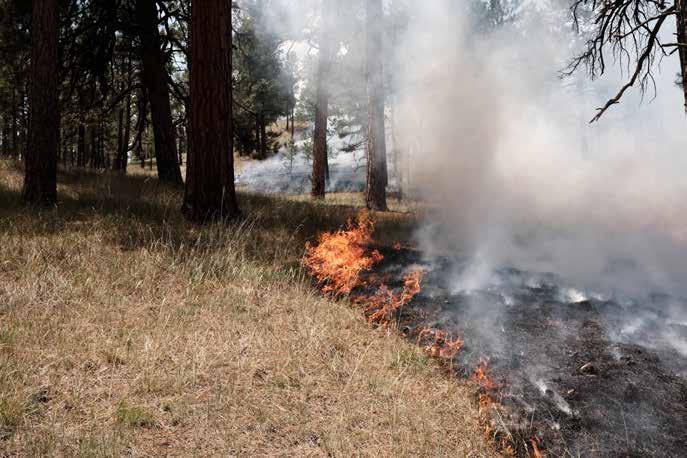Overview 2023: United States
FEWER FIRES, BIGGER IMPACT
BY RICH MCCREA
The 2023 fire season in the United States was particularly challenging, with many large incidents, including the Lahaina Fire on the island of Maui in Hawaii that killed 99 people. However, while Texas and Louisiana endured higher than normal wildfire activity, other regions experienced a quiet season.
Data from the National Interagency Fire Center, the daily Incident Management Situation Report (IMSR), Geographic Area Coordination Centers (GACC), and agency public information officers provided valuable insight. As of Sept. 22, more than 44,011 wildfires had burned 2,342,143 acres (947,831 hectares). The 10-year average wildfire occurrence for the United States (2013-2022) is 44,575 fires burning 6,046,153 acres (2,446,791 hectares) – a slower overall season.
The Alaska GACC experienced an abbreviated fire season with fewer than 300,000 acres (121,405 hectares) burned as of mid-September. In an average year, Alaska wildfires blacken about 650,000 acres (263,045 hectares). In 2023 there was limited large fire activity until drier weather and lightning occurred the third week of July.
In Texas and Louisiana, wildfire numbers and acres burned were much higher than normal. Extensive areas of southern pine occur across much of west Texas and Louisiana. One of the larger fires that occurred in western Louisiana – the Tiger Island fire – ignited Aug. 22 and burned across pine plantations of multiple ages; it was a challenging incident due to drought, high temperatures and heavy areas of downed woody fuels from Hurricane Laura in 2020. As of Sept. 22, 31,290 acres (12,662 hectares) had burned, with containment estimated at 84 per cent. The Southern GACC incident management team (SA Blue Team) was mobilized to manage this wildfire. The Tiger Island fire was the largest blaze to ever occur in Louisiana and was unprecedented in terms of fire behavior and size.
The Lahaina fire burned 2,170 acres (878 hectares) with 2,207 structures damaged or destroyed, and 97 confirmed fatalities. Extreme fire behavior occurred that day with wind gusts more than 50 miles per hour and very dry fuels due to low humidities and drought conditions. Officials in Hawaii say this wildfire was one of the deadliest natural disasters in the state’s history.
The Confederated Salish Kootenai Tribe (CSKT) in western Montana experienced five large fires from July to August that burned more than 43,000 acres (17,401 hectares). On July 24 and July 30 lightning storms pummeled the Mission and Salish mountains and ignited four wildfires. Another fire that was ignited at the same time was human caused. Propelled by high winds with hot temperatures these fires raged across tribal lands, with extreme fire behavior, as flames torched through timber stands and spotted long range. At one point two of these fires spotted across the Flathead River, which must have greatly alarmed the crews on the scene. The Northern Rockies GACC Team 8 was mobilized for three of these fires and the CSKT Division of Fire managed the other blazes.
Another agency that faced challenges was the National Park Service in Olympic National Park in northwestern Washington state. Seven fires were ignited by lightning in the park on Aug. 28, and the flames blackened 4,135 acres (1,673 hectares) by late August. Fire operations included protecting infrastructure and creating fuel breaks (defensible space) to limit fire spread in selected areas. Tactics to contain the blazes included using natural barriers such as mountain ranges, high alpine zones, and rivers. Fire is an integral part of the forested ecosystems on the Olympic Peninsula and plants and animals have evolved with fire for thousands of years. Even the emerald hued rainforests in the deep river valleys, such as the Quinault River, have evolved with fire, which naturally occurred at long term intervals.
The Gila National Forest in southwestern New Mexico experienced a busy fire season, with numerous lightning fires in July. The Gila is very mountainous with three extensive wilderness areas, blanketed by stands of ponderosa pine, pinyonjuniper, and mixed conifer, broken up by sweeps of bunch grass and oak. During the summer, 12 fires were managed for resource benefits, which burned a total of 132,000 acres (53,418 hectares).

The devastating fire season in Canada had several impacts in the United States with smoke from those conflagrations impacting states from Montana to Vermont and even as far south as Colorado. While wildfire smoke wedged south, U.S. assistance flowed north to Canada. As of Sept. 22, support to the Canadian provinces and northern territories included five fire crews of 18 to 20 people, two incident management teams, five overhead personnel, and nine engines.
The 2023 fire season peaked at the end of August into early September when more than 20,000 personnel were employed on around 70 large blazes across the United States. The fire season slowly waned and by late September 8,300 personnel were deployed on large blazes (Sept. 22 IMSR report). Significant fires were ongoing and were expected to continue through September into November in Washington, Oregon, California, and other states. Fall weather unfortunately can bring windy and very dry conditions along the west coast, with Santa Anna and east wind episodes that can rapidly turn small fires into conflagrations.

In late September, fires were burning in the Sierra Nevada range, Klamath Mountains, Siskiyou Mountains, Cascades, and Olympic Mountains. These fires were generally difficult to control due to the steep and rugged terrain and heavy fuels. Fire crews faced arduous hikes, long days, and short cold nights with the hope that rain and snow would slow the blazes or that flames could be herded into rock slides and backfires would hold.

